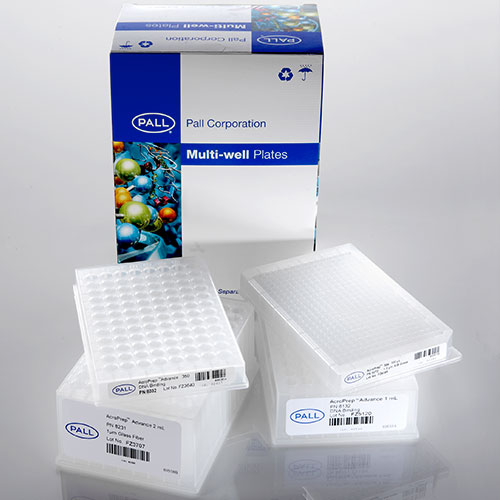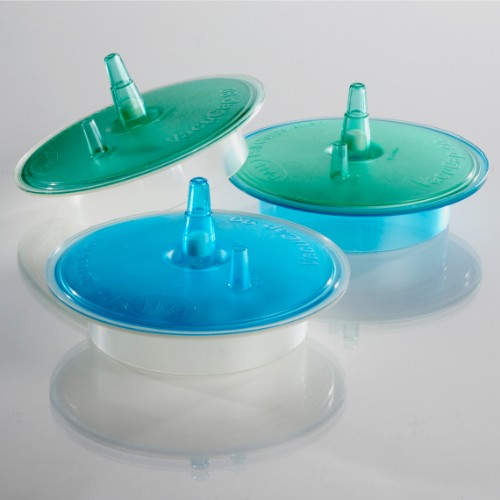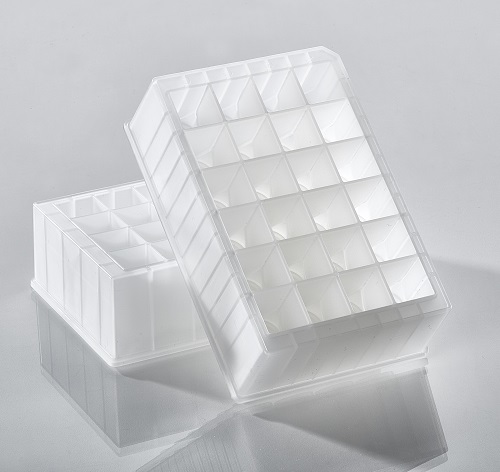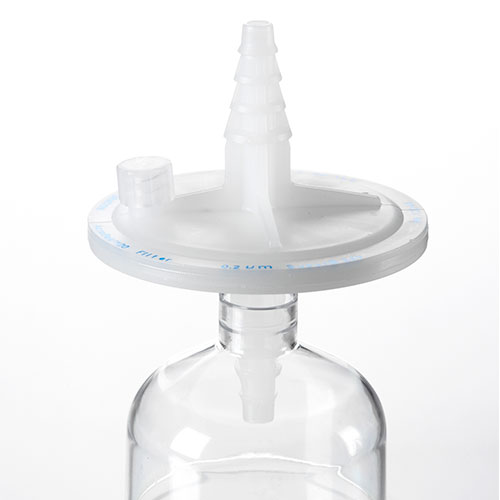


Developing high-producing, stable cell lines is fundamental to the production of biotherapeutics such as monoclonal antibodies, bi-specific monoclonal antibodies, fusion proteins and vaccines. The expense of the drug discovery process is well recognized. To reduce development costs, there is increasing pressure on researchers to quickly and efficiently maneuver through the early stages of biotherapeutic discovery and biotherapeutic candidate selection. Key to driving efficiency is to quickly generate and select clonal cell lines that deliver high concentrations of quality recombinant protein, while screening out clone candidates that may fail in process scale-up as early as possible.
As a global leader in high-tech filtration and purification systems, Pall offers solutions to support researchers throughout the cell line development process. High performance proprietary membranes address the challenges of complex next generation biologics, while supporting scale-up to commercial manufacturing processes. Innovative and time-saving products for filtration, separation, and sample preparation help streamline workflows and ensure sterility from gene editing, through cell culture, to omics analysis.
Learn more by selecting an option below
Gene editing has advanced in recent years through molecular tools such as zinc finger nucleases (ZFN), transcription activator-like effector nucleases (TALENs), and most recently, the CRISPR/Cas9 system. These techniques have driven considerable improvements in accuracy and ease-of-use when engineering cell lines for optimal biotherapeutic production.
Despite technical advancements, multi-step gene editing workflows remain resource intensive involving: gene selection, PCR amplification, DNA extraction, DNA clean up, restriction enzyme digest, ligation, and ultimately, insert verification. Constant vigilance is required to avoid contamination and downstream complications. Standard techniques often involve multiple purification steps, each one associated with significant product loss. Large amounts of quality DNA are therefore necessary to guarantee a successful cellular transformation or transfection.
Pall centrifugal ultrafiltration devices simplify many common nucleic acid preparation procedures. Restriction digest of plasmid DNA and DNA amplification products can be carried out within the centrifugal device. DNA constructs can be concentrated and desalted while simultaneously allowing primers and other contaminants to pass into the discarded filtrate during a five-minute centrifugation step. Ligation of the DNA fragments into the vector can also be completed directly within the ultrafiltration device rendering the product ready for transformation into competent cells. Reducing unnecessary transfers and liquid handling manipulation of the sample leads to significant savings in time, labor, and starting materials.
Nucleic acid binding (NAB) products provide flexibility, reduced risk of cross-contamination, and a smooth flow for sample processing. The NAB Nanosep® centrifugal device incorporates a high-binding innovative double layer glass fiber membrane. High-quality and quantity yields with even recovery of fragments as small as 50bp up to 10,000bp, support multiple downstream applications, while saving time and resource by removing the need to process additional samples.
NAB products are available in Nanosep® single tube spin device format, and the high-throughput AcroPrep™ Advance 96-well filter plate format. This media offers researchers the flexibility to purify plasmid DNA (pDNA), and genomic DNA (gDNA), or total RNA in a single device.
Simplify gene editing workflows and streamline inventory orders with our ultrafiltration and purification systems.


Effective strain construction through the transformation of bacterial cells (such as E. coli), or transfection of yeast (such as S. cerevisiae) or mammalian cells (such as CHO, HEK) requires efficient recovery, concentration, and delivery of the target nucleic acid fragments.
Preparation of small volumes of media for transformation or transfection requires specific strain constructs with variations in amino acids or antibiotics. Sterile syringe filters help you to maintain sterility when handling small media volumes that cannot be autoclaved. Pall Laboratory 0.2 µm sterile filters and capsules ensure that small or large batches of liquid media are efficiently filtered to remove the risk of contamination. Where further concentration of the construct is required prior to introduction into the cells, our wide range of low molecular weight cut-off (3 to 1,000 kDa) ultracentrifugation devices and plates streamline sample handling and preparation processes.


Cloning and expression of proteins through bacterial, yeast, insect, or mammalian cell culture presents specific challenges. Aseptic techniques and sterility in cell culture are paramount to avoid contamination and downstream complications. Contamination of cell cultures can lead to poor cell health and cell death, reduced cell line performance, low product yield, and loss of confidence in the integrity of the sample extracted.
In addition to ensuring aseptic or sterile culture conditions, media and nutrient feeds need to be filter sterilized to avoid introducing contaminants to the cell culture environment. Cross-contamination when handling cell lines also needs to be avoided to ensure reproducible results.
Pall Laboratory’s low protein binding 0.2 µm filter media offer fast and efficient filtration to maintain sterility in cell culture applications. From small feed volumes of a few milliliters to over 100 liters, proprietary dual layer membranes enable sterile filtration of nutrient rich media and supplements while ensuring valuable nutrients are not lost.
Our 0.1 µm Supor® membrane, an inherently hydrophilic polyethersulfone (PES) membrane that is retentive of mycoplasma, offers the best line of protection against mycoplasma contamination in serum or serum-containing media for cell culture
Our range of in-line vent air filters ensure sterility of air coming into the cell growing vessels, and gasses coming out of the vessel while protecting liquids from entering into devices such as a vacuum pump.












Screening clones to identify those carrying the desired genomic changes and expressing the target protein, can be carried out through traditional approaches such as: western blotting, enzyme-linked immunosorbent assay (ELISA), fluorescence-activated cell sorting (FACS), flow cytometry, or utilizing high content imaging systems. Maintaining sterility and clonality is important for purity and homogeneity of the target protein. Screening large numbers of clones as quickly as possible to select those of value for further analysis is essential.
In addition to sterile filtration systems to ensure media and environmental sterility, Pall Laboratory offers centrifugal devices and filter plates which simplify protein sample preparation, gDNA and mRNA purification. The AcroPrep™ Advance filter plate is designed to reduce the risk of cross-contamination and create a smooth liquid flow for sample processing and high-throughput screening. Our high-sensitivity protein binding membranes designed for protein detection analysis applications, such as western blotting, exhibit low background noise for clarity and sensitivity of results. Immobilized proteins can be used directly for sequencing, providing flexibility in the workflow.
Ensure clear results for flow cytometry and cell labeling by preparing samples with AcroPrep Advance filter plates equipped with 30-40 µm PP/PE media. These plates are designed to capture clumps of cellular aggregates that could otherwise clog the flow chamber, disrupt the workflow, and impact clarity of results. All cell labeling and detection processes can be carried out in one plate (detection of cell surface antigens or intracellular proteins) without the need for aspiration after centrifugation reducing the potential for product loss. Pall filter plates allow you to remove, wash or label cells by vacuum or centrifugation simply, quickly, and easily.





Following identification of clones expressing the protein of interest, clonal amplification, cell harvest, media collection and sampling is required. Streamlining these processes through efficient sample preparation and purification of the biomolecules for analysis can save significant time and resources. Comprehensive characterization of the expressed target protein in terms of yield, purity, stability, structure, and function is essential to select suitable clones for further optimization and scale-up. To aid in this determination several techniques can be used, including next generation sequencing, immunohistochemistry, and mass spectroscopy.
High-performance depth filter media from Pall Laboratory efficiently removes cells and clarifies cell lysates with low hold-up volumes, increasing product recovery.
Contaminants in biotherapeutics are of great concern. Endotoxin, a bacterial toxic liposaccharide (LPS), can be introduced from plasmid preparations and bacterial protein expression. Endotoxin must be removed to avoid toxicity and interference with downstream cell-based assays. While intact bacteria can be captured using a 0.2 µm filter, LPS are much smaller and can be more challenging to capture. An effective method of removal of the negatively charged LPS is to use a substrate with a positive charge. Pall Laboratory offer Acrodisc® Units with Mustang® E Membrane for effective removal of endotoxin.
Our simple-to-use, innovative nucleic acid binding centrifugal devices, incorporate double layer glass fiber membranes, providing high yields and the flexibility to purify genomic DNA and mRNA in a single device to support multiple downstream applications. Pall Laboratory nucleic acid purification solutions save time by removing unnecessary steps. The automation-friendly and high throughput 96-well format eliminates the need for sequential sample preparations further increasing the processing speed of workflows.
Pall Laboratory offers high-sensitivity protein binding membranes designed for protein detection analysis using techniques such as western blotting. Low background noise ensures clarity and sensitivity of results. Immobilized proteins can be used directly for sequencing, providing flexibility in the workflow.













Developing high-producing, stable cell lines is fundamental to the production of biotherapeutics such as monoclonal antibodies, bi-specific monoclonal antibodies, fusion proteins and vaccines. The expense of the drug discovery process is well recognized. To reduce development costs, there is increasing pressure on researchers to quickly and efficiently maneuver through the early stages of biotherapeutic discovery and biotherapeutic candidate selection. Key to driving efficiency is to quickly generate and select clonal cell lines that deliver high concentrations of quality recombinant protein, while screening out clone candidates that may fail in process scale-up as early as possible.
As a global leader in high-tech filtration and purification systems, Pall offers solutions to support researchers throughout the cell line development process. High performance proprietary membranes address the challenges of complex next generation biologics, while supporting scale-up to commercial manufacturing processes. Innovative and time-saving products for filtration, separation, and sample preparation help streamline workflows and ensure sterility from gene editing, through cell culture, to omics analysis.
Need Help?
Gene editing has advanced in recent years through molecular tools such as zinc finger nucleases (ZFN), transcription activator-like effector nucleases (TALENs), and most recently, the CRISPR/Cas9 system. These techniques have driven considerable improvements in accuracy and ease-of-use when engineering cell lines for optimal biotherapeutic production.
Despite technical advancements, multi-step gene editing workflows remain resource intensive involving: gene selection, PCR amplification, DNA extraction, DNA clean up, restriction enzyme digest, ligation, and ultimately, insert verification. Constant vigilance is required to avoid contamination and downstream complications. Standard techniques often involve multiple purification steps, each one associated with significant product loss. Large amounts of quality DNA are therefore necessary to guarantee a successful cellular transformation or transfection.
Pall centrifugal ultrafiltration devices simplify many common nucleic acid preparation procedures. Restriction digest of plasmid DNA and DNA amplification products can be carried out within the centrifugal device. DNA constructs can be concentrated and desalted while simultaneously allowing primers and other contaminants to pass into the discarded filtrate during a five-minute centrifugation step. Ligation of the DNA fragments into the vector can also be completed directly within the ultrafiltration device rendering the product ready for transformation into competent cells. Reducing unnecessary transfers and liquid handling manipulation of the sample leads to significant savings in time, labor, and starting materials.
Nucleic acid binding (NAB) products provide flexibility, reduced risk of cross-contamination, and a smooth flow for sample processing. The NAB Nanosep® centrifugal device incorporates a high-binding innovative double layer glass fiber membrane. High-quality and quantity yields with even recovery of fragments as small as 50bp up to 10,000bp, support multiple downstream applications, while saving time and resource by removing the need to process additional samples.
NAB products are available in Nanosep® single tube spin device format, and the high-throughput AcroPrep™ Advance 96-well plate format. This media offers researchers the flexibility to purify plasmid DNA, and genomic DNA, or total RNA in a single device.
Simplify gene editing workflows and streamline inventory orders with our ultrafiltration and purification systems.








Effective strain construction through the transformation of bacterial cells (such as E. coli), or transfection of yeast (such as S. cerevisiae) or mammalian cells (such as CHO, HEK) requires efficient recovery, concentration, and delivery of the target nucleic acid fragments.
Preparation of small volumes of media for transformation or transfection requires specific strain constructs with variations in amino acids or antibiotics. Sterile syringe filters help you to maintain sterility when handling small media volumes that cannot be autoclaved. Pall Laboratory 0.2 µm sterile filters and capsules ensure that small or large batches of liquid media are efficiently filtered to remove the risk of contamination. Where further concentration of the construct is required prior to introduction into the cells, our wide range of low molecular weight cut-off (3 to 1,000 kDa) ultracentrifugation devices and plates streamline sample handling and preparation processes.












Cloning and expression of proteins through bacterial, yeast, insect, or mammalian cell culture presents specific challenges. Aseptic techniques and sterility in cell culture are paramount to avoid contamination and downstream complications. Contamination of cell cultures can lead to poor cell health and cell death, reduced cell line performance, low product yield, and loss of confidence in the integrity of the sample extracted.
In addition to ensuring aseptic or sterile culture conditions, media and nutrient feeds need to be filter sterilized to avoid introducing contaminants to the cell culture environment. Cross-contamination when handling cell lines also needs to be avoided to ensure reproducible results.
Pall Laboratory’s low protein binding 0.2 µm filter media offer fast and efficient filtration to maintain sterility in cell culture applications. From small feed volumes of a few milliliters to over 100 liters, proprietary dual layer membranes enable sterile filtration of nutrient rich media and supplements while ensuring valuable nutrients are not lost.
Our 0.1 µm Supor® membrane, an inherently hydrophilic polyethersulfone (PES) membrane that is retentive of mycoplasma, offers the best line of protection against mycoplasma contamination in serum or serum-containing media for cell culture
Our range of in-line vent air filters ensure sterility of air coming into the cell growing vessels, and gasses coming out of the vessel while protecting liquids from entering into devices such as a vacuum pump.












Screening clones to identify those carrying the desired genomic changes and expressing the target protein, can be carried out through traditional approaches such as: western blotting, enzyme-linked immunosorbent assay (ELISA), fluorescence-activated cell sorting (FACS), flow cytometry, or utilizing high content imaging systems. Maintaining sterility and clonality is important for purity and homogeneity of the target protein. Screening large numbers of clones as quickly as possible to select those of value for further analysis is essential.
In addition to sterile filtration systems to ensure media and environmental sterility, Pall Laboratory offers centrifugal devices and filter plates which simplify protein sample preparation, gDNA and mRNA purification. The AcroPrep™ Advance filter plate is designed to reduce the risk of cross-contamination and create a smooth liquid flow for sample processing and high-throughput screening. Our high-sensitivity protein binding membranes designed for protein detection analysis applications, such as western blotting, exhibit low background noise for clarity and sensitivity of results. Immobilized proteins can be used directly for sequencing, providing flexibility in the workflow.
Ensure clear results for flow cytometry and cell labeling by preparing samples with AcroPrep Advance filter plates equipped with 30-40 µm PP/PE media. These plates are designed to capture clumps of cellular aggregates that could otherwise clog the flow chamber, disrupt the workflow, and impact clarity of results. All cell labeling and detection processes can be carried out in one plate (detection of cell surface antigens or intracellular proteins) without the need for aspiration after centrifugation reducing the potential for product loss. Pall filter plates allow you to remove, wash or label cells by vacuum or centrifugation simply, quickly, and easily.










Following identification of clones expressing the protein of interest, clonal amplification, cell harvest, media collection and sampling is required. Streamlining these processes through efficient sample preparation and purification of the biomolecules for analysis can save significant time and resources. Comprehensive characterization of the expressed target protein in terms of yield, purity, stability, structure, and function is essential to select suitable clones for further optimization and scale-up. To aid in this determination several techniques can be used, including next generation sequencing, immunohistochemistry, and mass spectroscopy.
High-performance depth filter media from Pall Laboratory efficiently removes cells and clarifies cell lysates with low hold-up volumes, increasing product recovery.
Contaminants in biotherapeutics are of great concern. Endotoxin, a bacterial toxic liposaccharide (LPS), can be introduced from plasmid preparations and bacterial protein expression. Endotoxin must be removed to avoid toxicity and interference with downstream cell-based assays. While intact bacteria can be captured using a 0.2 µm filter, LPS are much smaller and can be more challenging to capture. An effective method of removal of the negatively charged LPS is to use a substrate with a positive charge. Pall Laboratory offer Acrodisc® Units with Mustang® E Membrane for effective removal of endotoxin.
Our simple-to-use, innovative nucleic acid binding centrifugal devices, incorporate double layer glass fiber membranes, providing high yields and the flexibility to purify genomic DNA and mRNA in a single device to support multiple downstream applications. Pall Laboratory nucleic acid purification solutions save time by removing unnecessary steps. The automation-friendly and high throughput 96-well format eliminates the need for sequential sample preparations further increasing the processing speed of workflows.
Pall Laboratory offers high-sensitivity protein binding membranes designed for protein detection analysis using techniques such as western blotting. Low background noise ensures clarity and sensitivity of results. Immobilized proteins can be used directly for sequencing, providing flexibility in the workflow.




















Talk to an expert or request a sample / demo